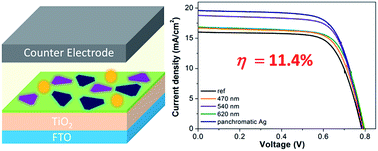Panchromatic quasi-monolayer of Ag nanoparticles for high-efficiency dye-sensitized solar cells†
Abstract
We developed a panchromatic quasi-monolayer of Ag nanoparticles (NPs) whose localized surface plasmon resonances all take place in the visible range and applied this technique to fabricate dye-sensitized solar cells (DSSCs). Three kinds of Ag NPs, whose λmax were at 540, 620 and 470 nm, were fabricated. We immobilized them on a photoactive film of TiO2 NPs coated with poly(4-vinylpyridine) (P4VP), then coated P4VP again, and then deposited a scattering layer. Most Ag NPs were immobilized individually without aggregation, and formed a quasi-monolayer. By constructing a panchromatic quasi-monolayer between the photoactive and scattering layers, the efficiency was enhanced from 8.9 ± 0.3% to 11.0 ± 0.4%, mainly by enhancing the photocurrent density. The photocurrent density might be enhanced by enhancement of light absorption and electron transfer yield. Absorption of dye molecules might be enhanced on or near the surface of Ag NPs by the localized surface plasmons. Absorption of dye molecules, particularly molecules not adsorbed on or near the surface, could be enhanced by the scattered light, since the quasi-monolayer of Ag NPs scattered light strongly. Owing to the enhanced dye absorption, we could reduce greatly the thickness of the photoactive layer. The thickness was about 4.5 μm, corresponding to about one-half the optimum length for DSSCs which did not include metal NPs. The electron transfer yield to the electrode might be enhanced by reducing the electron transfer length. Our general method could be used in the fabrication of other types of solar cells.


 Please wait while we load your content...
Please wait while we load your content...